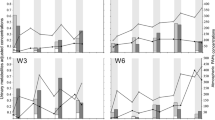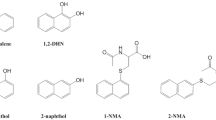Abstract
Objectives: External and internal exposure to naphthalene was examined in the most important industries that are typically concerned with polycyclic aromatic hydrocarbon (PAH)-induced diseases (cancer). Furthermore, a control collective from the general population was investigated. Methods: External naphthalene was determined by personal air sampling (n=205). The internal exposure was examined by urinary metabolites 1-naphthol and 2-naphthol (n=277). Results: Highest median concentrations of naphthalene in air were found in converter infeed (93.2 μg/m3) and coal-tar distillation (35.8 μg/m3). Moderate and low levels were determined in coking plants (14.5 μg/m3) and in the production of refractories (6.1 μg/m3) and graphite electrodes (0.7 μg/m3). Biological monitoring revealed concentrations of the sum of both metabolites [(1+2)-NOL] in smokers to be increased by 1.6–6.4 times compared with that in non-smokers at the same workplaces. Among non-smokers we found high median (1+2)-NOL levels in converter bricklayers (120.1 μg/l), in coal-tar distillation workers (56.0 μg/l) and in coking plant workers (29.5 μg/l). (1+2)-NOL concentrations around 10 μg/l were found in the production of refractories and graphite electrodes. There was a rough coherency between external and internal naphthalene exposure. In the controls, median (1+2)-NOL concentrations were 10.9 μg/l in non-smokers’ urine and 40.3 μg/l in smokers’ urine samples. Conclusions: Actual conditions of occupational hygiene at the workplaces investigated in this comprehensive study are better than those that current limit values of 50,000 μg/m3 (TLV, TRK) seem to induce. It has become obvious that tobacco smoking is a crucial confounding factor in biological monitoring of naphthalene-exposed humans, making interpretation of occupationally increased naphthol excretions very difficult at low exposure levels.



Similar content being viewed by others
References
BGBl (1993) Bekanntmachungen des Bundesgesundheitsamtes: Bewertung der Luftqualität in Innenräumen. Bundesgesundheitsblatt 3:117–118
Bieniek G (1994) The presence of 1-naphthol in the urine of industrial workers exposed to naphthalene. Occup Environ Med 51:357–359
Bieniek G (1997) Urinary naphthols as an indicator of exposure to naphthalene. Scand J Work Environ Health 23:414–420
Bieniek G (1998) Aromatic and polycyclic hydrocarbons in air and their urinary metabolites in coke plant workers. Am J Ind Med 34:445–454
Bouchard M, Pinsonneault L, Tremblay C, Weber JP (2001) Biological monitoring of environmental exposure to polycyclic aromatic hydrocarbons in subjects living in the vicinity of a creosote impregnation plant. Int Arch Occup Environ Health 74:505–513
Chuang JC, Callahan PJ, Lyu CW, Wilson NK (1999) Polycyclic aromatic hydrocarbon exposures of children in low-income families. J Exp Anal Environ Epidemiol 2:85–98
DFG (2001) Deutsche forschungsgemeinschaft, commission for the investigation of health hazards of chemical compounds in the work area. MAK and BAT values 2001. Report No 37. Wiley-VCH, Weinheim
Eichhorn U, Gonzalez-Reche LM, Rossbach B, Angerer J, Drexler H (2002) High throughput online HPLC-Methode zur Objektivierung einer Passivrauchbelastung am Arbeitsplatz. Dokumentationsband über die 42. Jahrestagung der Deutschen Gesellschaft für Arbeitsmedizin und Umweltmedizin e.V., München. Rindt-Druck, Fulda, pp 503–505
Hansen AM, Poulsen OM, Sigsgaard T, Christensen JM (1994a) The validity of determination of alpha-naphthol in urine as a marker for exposure to polycyclic aromatic hydrocarbons. Anal Chim Acta 291:341–347
Hansen AM, Omland O, Poulsen OM, Sherson D, Sigsgaard T, Christensen JM, Overgaard E (1994b) Correlation between work process-related exposure to polycyclic aromatic hydrocarbons and urinary levels of alpha-naphthol, beta-naphthylamine and 1-hydroxypyrene in iron foundry workers. Int Arch Occup Environ Health 65:385–394
Heikkilä P, Luotamo M, Pyy L, Riihimaki V (1995) Urinary 1-naphthol and 1-pyrenol as indicators of exposure to coal tar products. Int Arch Occup Environ Health 67:211–217
Heikkilä PR, Luotamo M, Riihimaki V (1997) Urinary 1-naphthol excretion in the assessment of exposure to creosote in an impregnation facility. Scand J Work Environ Health 23:199–205
Hill RH, Head SL, Baker S, Gregg M, Shealy DB, Bailey SL, Williams CC, Sampson EJ, Needham LL (1995) Pesticide residues in urine of adults living in the United States: reference range concentrations. Environ Res 71:99–108
IARC (2002) International Agency for Research on Cancer: monographs on the evaluation of carcinogenic risks to humans: some traditional herbal medicines, some mycotoxins, naphthalene and styrene, vol 82. IARC, Lyon
Kim H, Kim YD, Lee H, Kawamoto T, Yang M, Katoh T (1999) Assay of 2-naphthol in human urine by high-performance liquid chromatography. J Chromatogr B Biomed Sci Appl 734:211–217
Kim H, Cho SH, Kang JW, Kim YD, Nan HM, Lee CH, Lee H, Kawamoto T (2001) Urinary 1-hydroxypyrene and 2-naphthol concentrations in male Koreans. Int Arch Occup Environ Health 74:59–62
Kuusimäki L, Peltonen Y, Kyyro E, Mutanen P, Peltonen K, Savela K (2002) Exposure of garbage truck drivers and maintenance personnel at a waste handling centre to polycyclic aromatic hydrocarbons derived from diesel exhaust. J Environ Monit 4:722–727
Nan HM, Kim H, Lim HS, Choi JK, Kawamoto T, Kang JW, Lee CH, Kim YD, Kwon EH (2001) Effects of occupation, lifestyle and genetic polymorphisms of CYP1A1, CYP2E1, GSTM1 and GSTT1 on urinary 1-hydroxypyrene and 2-naphthol concentrations. Carcinogenesis 22:787–793
NIOSH (1994) Polynuclear aromatic hydrocarbons by HPLC. In: Cassinelli ME, O’Conner PE (eds) NIOSH manual of analytical methods (NMAM), 4th edn. National Institute for Occupational Safety and Health, Washington
Preuss R, Angerer J (2003) Simultaneous determination of 1- and 2-naphthol in human urine using on-line clean-up column switching HPLC fluorescence detection. J Chromatogr B 801:307–316
Preuss R, Angerer J, Drexler H (2003a) Naphthalene—an environmental and occupational toxicant. Int Arch Occup Environ Health 76:556–576
Preuss R, Rossbach B, Mueller J, Angerer J (2003b) Eine deutschlandweite Studie zur inneren und äusseren Exposition gegenüber Polyzyklischen Aromatischen Kohlenwasserstoffen (PAK) am Arbeitsplatz. Gefahrst Reinhalt L 63:7–14
Preuss R, Rossbach B, Korinth G, Müller J, Drexler H, Angerer J (2003c) Innere und äussere Belastung mit Polycyclischen Aromatischen Kohlenwasserstoffen (PAK) bei Beschäftigten eines Bitumen verarbeitenden Betriebes. Gefahrst Reinhalt L 63:461–467
Scherer G, Meger-Kossien I (2000) Cotinin. In: Angerer J, Schaller KH (eds) Analysen in biologischem material, 14. Lieferung, Loseblattsammlung, Wiley-VCH, Weinheim
Serdar B, Waidyanatha S, Zheng Y, Rappaport SM (2003) Simultaneous determination of urinary 1- and 2-naphthols, 3- and 9-phenanthrols, and 1-pyrenol in coke oven workers. Biomarkers 8:93–109
Shafik MT, Sullivan HC, Enos HF (1971) A method for the determination of 1-naphthol in urine. Bull Environ Contam Toxicol 53:274–279
Taussky HH (1954) A micro-colorimetric determination of creatinine in urine by the Jaffe’s reaction. J Biol Chem 208:853–861
US EPA (2003) US Environmental Protection Agency: electronic resource: http://www.epa.gov/ttn/atw/hlthef/naphthal.html#ref7
US National Toxicology Program (2000) Toxicology and carcinogenesis studies of naphthalene (CAS no.: 91-20-3) in F344/N rats (inhalation studies). Technical report series no. 91-20-3. NIH publication no. 01-4434. US Department of Health and Human Services, Public Health Service, National Institutes of Health, Research Triangle Park (NC)
Viau C, Hakizimana G, Bouchard M (2000) Indoor exposure to polycyclic aromatic hydrocarbons and carbon monoxide in traditional houses in Burundi. Int Arch Occup Environ Health 73:331–338
Yang M, Koga M, Katoh T, Kawamoto T (1999) A study for the proper application of urinary naphthols, new biomarkers for airborne polycyclic aromatic hydrocarbons. Arch Environ Contam Toxicol 36:99–108
Acknowledgements
The German Federation of Institutions for Statutory Accident Insurance and Prevention (HVBG) is acknowledged for its support of the national study “PAH exposure at the workplace”. We would like to express our gratitude to Dr. Rossbach (Mainz) and Mr. J. Müller (Erlangen), who organised and accomplished several investigations in various industrial plants. Special thanks go to all colleagues of the individual trade associations, as well as to the dedicated support by the doctors and security personnel of the companies, who helped us in every way. Namely, we want to thank: Dipl.-Ing. M. Böckler (BG Feinmechanik und Elektrotechnik, Köln); Dr. Ch. Bräu-Dümler (Röthenbach/Pegnitz); M. Dettmarg (Castrop-Rauxel); W. Diegelmann (Giessen); Dr. K. Etzler (Duisburg); D. Fendler (BG Feinmechanik und Elektrotechnik, Köln); Dr. U. Geisel-Straus (Bayreuth); Dr. U. Goergens (Bau-BG Rheinland und Westfalen, Wuppertal); Dr. F. Greff (Südwestliche Bau-BG, Saarbrücken); Dr. G. Hoffmann (Bau-BG Rheinland und Westfalen, Wuppertal); Dipl.-Chem. K. Kahl (Röthenbach/Pegnitz); Dr. Konzelmann (Bonn), Dr. H. Krieger (Giessen); Dipl.-Ing. R. Lange (Giessen); S. Lausmann (BG Feinmechanik und Elektrotechnik, Köln); Dr. J. Lilie (Castrop-Rauxel); Dipl.-Ing. F. Müller (Wiesbaden); K. Ortlepp (Salzgitter); P. Reim (Giessen); Dr. M. Scherenberg (Bau-BG Rheinland und Westfalen, Wuppertal); Dr. H. Schmittner (Südwestliche Bau-BG, Karlsruhe); Dipl.-Ing. H. Schulz (Bau-BG Rheinland und Westfalen, Wuppertal); M. Würstl (Marktredwitz). Dr. J. Angel-Peters (Südwestliche Bau-BG, Karlsruhe); Dr. W. Boenigk (Castrop-Rauxel); B. Fuchs (Salzgitter); Dr. H. Heinz (Salzgitter); Dipl.-Ing. H. Metge (BG der keramischen und Glasindustrie, Neuwied); Dr. H. Tillmanns (Frankfurt).
Author information
Authors and Affiliations
Corresponding author
Rights and permissions
About this article
Cite this article
Preuss, R., Drexler, H., Böttcher, M. et al. Current external and internal exposure to naphthalene of workers occupationally exposed to polycyclic aromatic hydrocarbons in different industries. Int Arch Occup Environ Health 78, 355–362 (2005). https://doi.org/10.1007/s00420-004-0593-3
Received:
Accepted:
Published:
Issue Date:
DOI: https://doi.org/10.1007/s00420-004-0593-3




